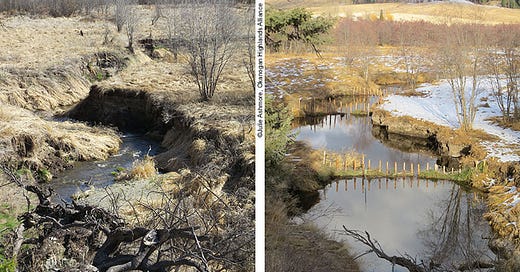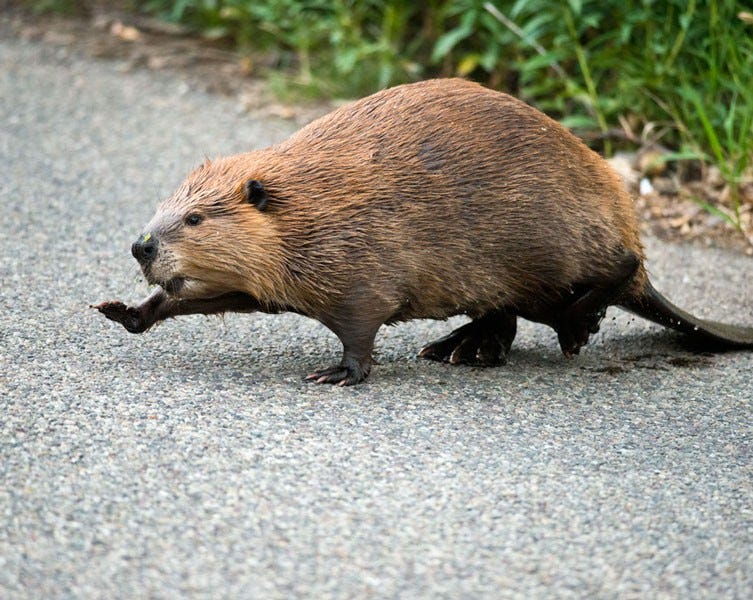Landscape Miracle Drugs, part 3
6/16/22 – Beavers, and beaver believers, are making a better world.
Hello everyone:
I’m away working on a Maine island this week, so the writing is a bit shorter than usual. You’ll find the conclusion to the discussion on beaver-led habitat restoration, as well as a slightly different list of links. Enjoy!
As always, please remember to scroll past the end of the post to read this week’s curated Anthropocene news.
Now on to this week’s writing:
Let’s pick up where I left off last week. I’d just discussed the Methow Beaver Project and the Beaver Believer documentary in the context of beaver-led habitat restoration work.
In lieu of available beavers, habitat restoration with beaver dam analogues – simple manmade dams built with posts, gravel, and woven branches – is being done to create some of the benefits that beavers bring. Sometimes these are meant to begin the job that beavers will eventually take up when they show up. Sometimes these are done because people don’t want beavers to show up… The photo at the top of the page here is a before-and-after image from a successful beaver dam analogue project. Note the water held on the landscape and the significantly increased potential for more species to thrive in the riparian habitat.
Beaver rewilding isn’t a new idea – initial efforts began as far back as the 1930s in part to control erosion and revitalize the fur industry – but it’s become more common and more successful. Spare a thought for the poor pioneering beavers who were parachuted into the wilds of Idaho in the 1940s… Here’s a story about the Idaho project from National Geographic, and here’s a quick video:
Beavers are of course on the move without our help, too. It’s not just irritated towns in Canada or national forests in Washington. For the first time ever – thanks to a warming climate – beavers have shown up on the tundra of northwest Alaska. It started slowly in the ‘80s and ‘90s, but now the beavers are spreading quickly. They’re doing their thing and adding biodiversity, but they may also be contributing to the warming of the permafrost. No one is sure yet.
And much, much farther south, in the Tierra del Fuego region of Chile and Argentina, where 20 Canadian beavers were imported in 1946 to create a fur industry – What could go wrong? – 110,000 beavers now create ecological havoc. The two nations are planning a coordinated eradication effort, but it will be extraordinarily difficult. According to National Geographic,
In a 2019 study, they counted 70,682 dams on the Argentine side of Tierra del Fuego’s main island. Other scientists have called beavers’ impact in Patagonia “the largest landscape-level alteration in sub-Antarctic forests since the last ice age.”
In Europe, the good news is that the Eurasian beaver is also spreading rapidly. There are more than 1.2 million beaver in Europe, most in the north (Norway, Sweden, the Baltic states, and western Russia). Much of this is through natural spread, though significant reintroductions are happening too. Beavers are, for example, back in London after 400 years, and are being reintroduced around the UK. Europe is the world’s most altered continental landscape (not that I think Europe is actually a continent, but that’s a topic for another day), so it’s an open question how much room will be found for beavers in Western Europe in particular. Even the Netherlands has welcomed them in, though death awaits any beaver who tries to excavate the dikes protecting the country from the sea.
Why bother adapting our lives to accommodate beavers? Why work hard at increasing their numbers? As I mentioned two weeks ago, they are a “keystone modifier” species which has always been essential for biodiversity in North America, particularly for wetlands and riparian zones (the shrubby habitat at the edge of lakes, rivers, and wetlands). Skip Lisle notes that “because wetlands are so important, beavers might create more value for other wildlife and society than any other animal on Earth.” Here’s how the Ontario Parks agency explains it:
By engineering its environment, the beaver changes the sameness of the forest into a variety of habitats. It opens up forest canopy by cutting down trees and letting in the light; it creates more “edge” along ponds and wetlands, increasing shrubs and other plants which are habitat for insects, birds and other wildlife. Streams turned into ponds create more water for fish to swim in. Brook trout thrive in deeper water, where springs feed the pond and keep things cool in summer. Beaver ponds provide slow-moving water for aquatic insects and other invertebrates, frogs, turtles, muskrat and mink. As plant variety increases, waterfowl move in. Ponds are safe places to nest and raise chicks. For instance, the Black Duck depends on beaver ponds for 86% of its nesting habitat.
But now we live in a world in which the ancient ecological roles beavers have played are only a portion of the benefits they can deliver. These services are more important now than ever. In a climate-addled world more prone to drought and fire, and in a time when vital, biodiverse wetlands are in radically steep decline, the beaver can be a bulwark against further loss.
North American landscapes, particularly out West, are burning up and drying out. Glaciers are disappearing and annual snowfall is decreasing. Even when the winter snows are good, less of the meltwater is making it into rivers because the dried-up landscape is soaking it up. Beaver-ponded streams hold the water on the land, increasing the recharging rate of the aquifer and creating wet fire-resistant refuges, watering holes, and oases for wildlife. “Riparian areas are estimated to have covered 40-50% of the landscape prior to European settlement,” according to the Methow Beaver Project, while “today they represent less than 2% of the western US.”
The West desperately needs a low-cost, low-impact method of keeping water on the landscape and protecting habitat from our fire-prone future. Nothing is better for the job than beavers. “We want these guys everywhere,” says Kent Woodruff, described by Ben Goldfarb as having “an evangelical gleam in his blue eyes.”
Goldfarb wrote another beaver article for High Country News in 2018, this one about bringing back beavers to re-green the desert. If you don’t picture beavers inhabiting the mountains of Nevada or the deserts of New Mexico, that’s because we exterminated them and then spent a century or two telling ourselves that these areas were always this dry. That’s ecological amnesia again, confident that watersheds full of dry sagebrush, not bird-filled wetlands and ponds, are normal. Goldfarb makes the excellent point that many of the thousands of concrete dams we built in the southwest were “partly designed to solve a problem the fur trade created.”
It’s worth saying that beaver reintroduction will not re-create the lost pre-Columbian ecosystems of North America, neither around Chesapeake Bay nor in the mountains of Nevada nor anywhere in between. Habitats have been permanently altered in ways that can be improved but not reversed. Climate change has already altered forests and weather patterns and will continue to do so with increasing intensity until humans get their act together and decarbonize civilization. Beavers may be a bulwark against climate change and biodiversity loss, but they will also be affected, particularly as things heat up. The tree species beavers prefer might be less available, for example, and the increased intensity of storms and flooding may limit their ability to manage water. We need beavers to do their landscape engineering, but they also need us to undo some of ours, before it’s too late.
Finally, for a deep dive into beaver-led habitat restoration, read this excellent, thorough interview with Dr. Michael Pollock, and for a much deeper dive, download the Beaver Restoration Guidebook (which Pollock helped to write) from the Beaver Coalition. The Beaver Coalition describes itself as
a coalition of optimistic, pragmatic professionals working to support a paradigm shift in how humans and beavers can live and work together. Our not-so-hidden agenda is to encourage people to be happy when a beaver family moves into the creek nearby.
And if you really want to enter the world of beaver believers, you should have been in Baltimore last week for BeaverCON 2022, a three-day conference subtitled “Building Climate Resilience: A Nature-Based Approach.” A similar conference, State of the Beaver, is held in Oregon in alternating years with BeaverCON.
Let’s hope that more coalitions of optimistic, pragmatic people are forming every day to support the paradigm shifts in all aspects of the Anthropocene. Better yet, let’s join them.
Thanks for sticking with me.
In other Anthropocene news:
Let’s start off this week with two articles relevant to my time on a beautiful Maine island this week:
From the Island Journal, here’s some perspective on the unique environment of Maine island forests.
For those of you dreaming of exploring the world on a boat but wondering how to afford it, Wooden Boat offers “A Sound Boat and Simple Living,” an account of how a family of four has lived affordably on a 32-ft boat for years while slowly circumnavigating the world:
And here’s some of the good news and good work that I’ve taken note of recently:
Dams are disappearing from Europe’s rivers.
The always intrepid Bill McKibben has apparently successfully influenced the White House to use the Defense Authorization Act to ramp up production of heat pumps. It’s not exactly what he had in mind, since he wanted the U.S. to produce millions of heat pumps for Europe to help them avoid buying Russian fossil fuels. Instead the White House caved in to the fossil fuel industry and is increasing sales of natural gas to Europe. Still, increased production of heat pumps for domestic use is a big win. Here’s the Presidential Memo.
One of the groups helping McKibben push his heat pump idea to the finish line was Third Act, a climate activism group for those over 60 years old. If you fit the bill, and are wondering how to help, please check it out.
Also, take a look at the NotTooLate climate project, described as “a project to invite newcomers to the climate movement, as well as provide climate facts and encouragement for people who are already engaged but weary.”








